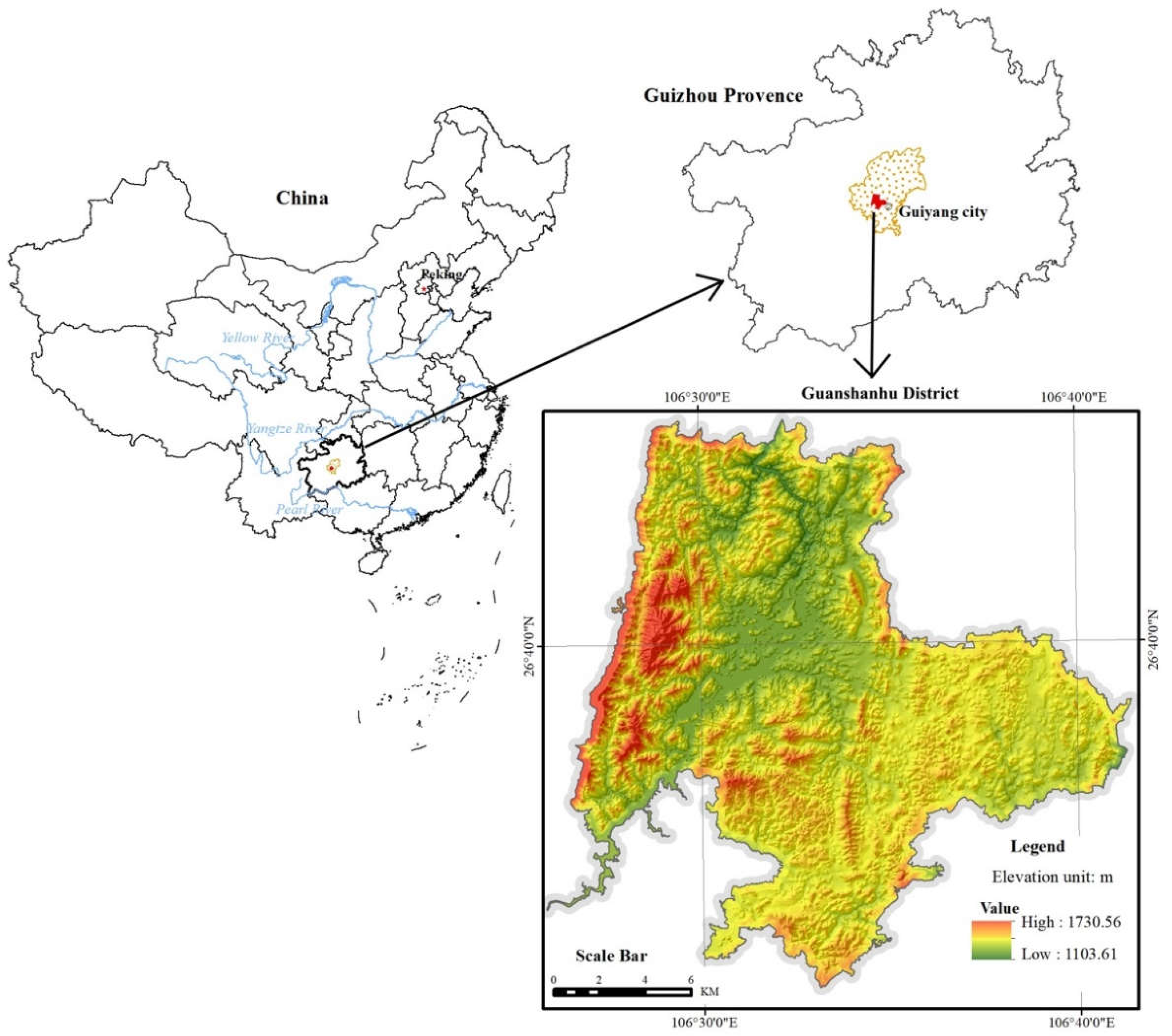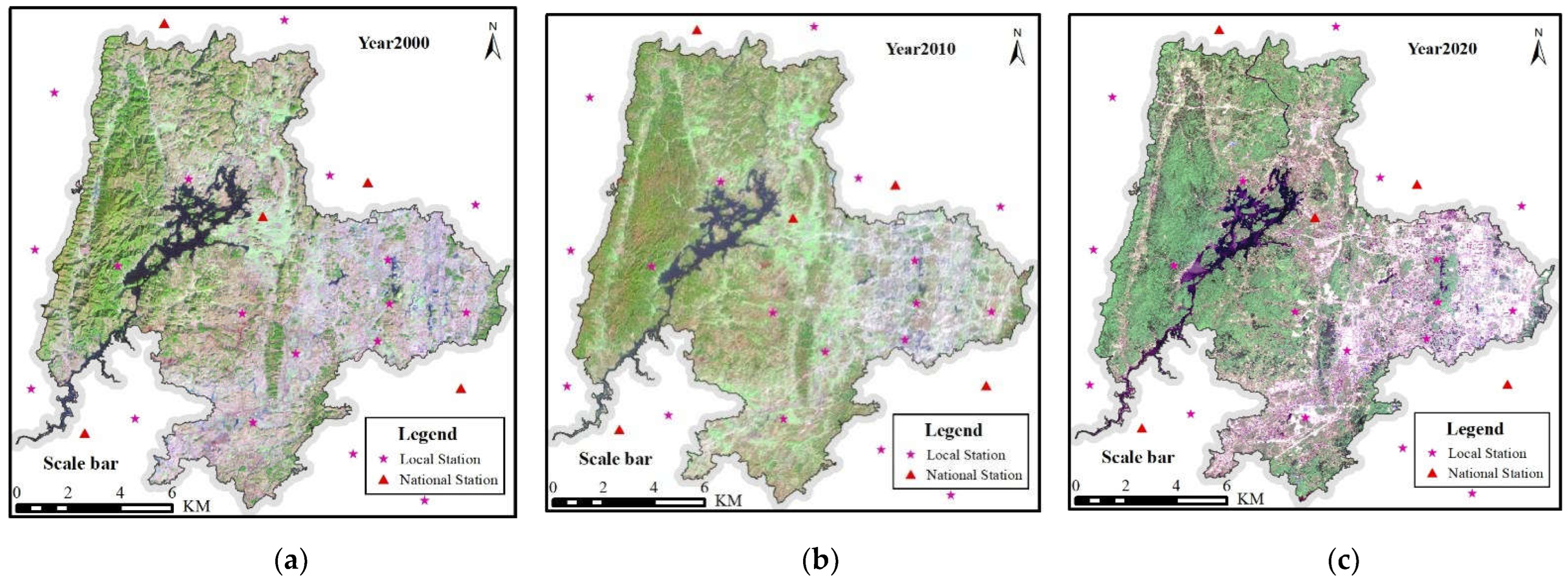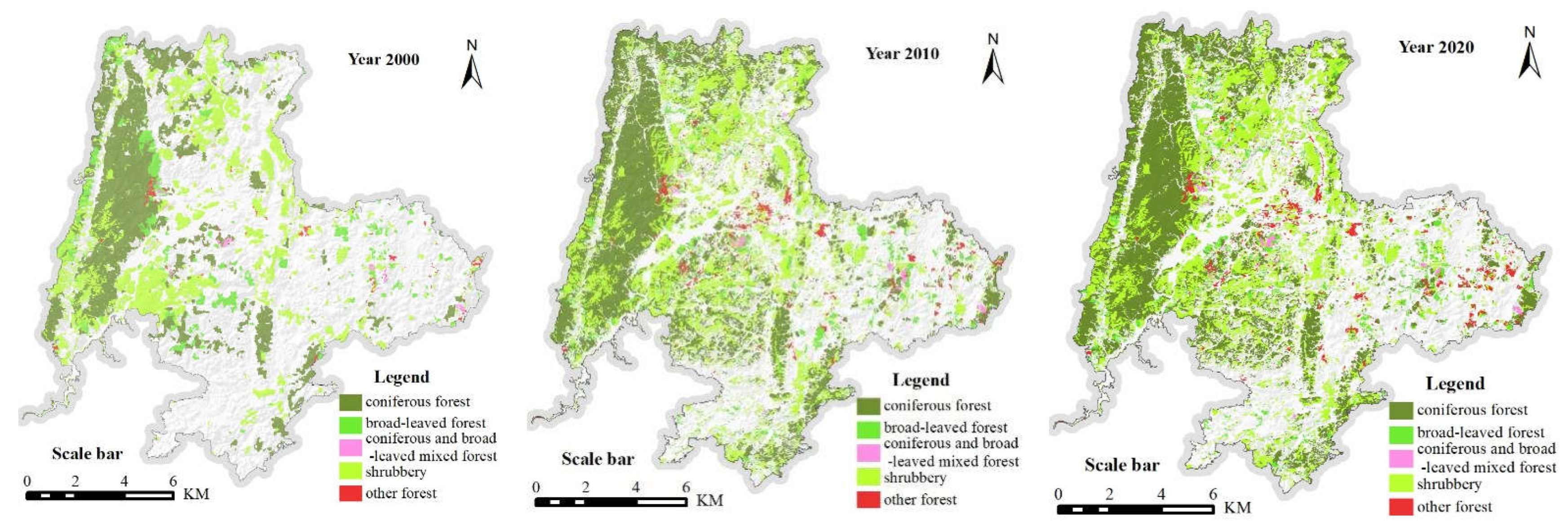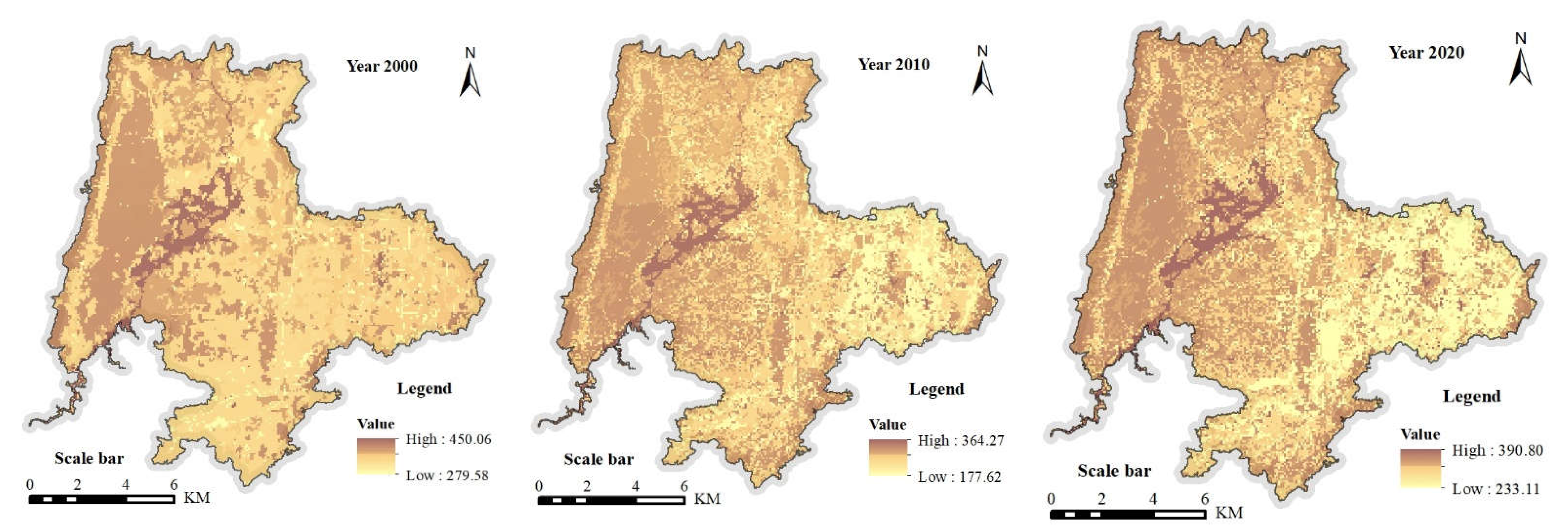Estimation of Forest Ecosystem Climate Regulation Service Based on Actual Evapotranspiration of New Urban Areas in Guanshanhu District, Guiyang, Guizhou Province, China
Abstract
:1. Introduction
2. Materials and Methods
2.1. Study Area
2.2. Materials and Method
2.3. Methodological Approach
- b.
- Calculation of climate regulation service. The climate regulation value of the forest ecosystem is estimated based on actual annual evapotranspiration in the year.
- c.
- The calculation flowchart. The forest ecosystem’s climate regulation value calculating flowchart is shown in Figure 3.
3. Results
3.1. Changes in Spatial Pattern and Structure of Ecosystem
3.2. Changes in Spatial Pattern and Structure of Forest Ecosystem
3.3. Actual Evapotranspiration of Forest Ecosystem and Its Climate Regulation Value
- The spatial distribution of actual evapotranspiration and its heterogeneity
- b.
- Forest climate regulation value based on evapotranspiration difference
4. Discussion
5. Conclusions
- The area of forest ecosystem in Guanshanhu District increased in the first decade since the millennium due to ecological engineering, then decreased in the following decade due to the establishment of the new urban area. In 2000, the area of forest ecosystem in the study region was 10,892.74 ha, accounting for 35.49% of the total area. In 2010, the area of the forest ecosystem was 15,571.90 ha, accounting for 50.73%. In 2020, the area of the forest ecosystem was 13,937.54 ha, accounting for 45.41%. The impervious surface area kept increasing rapidly, from 1146.82 ha, accounting for 3.74% in 2000, to 4103.52 ha, accounting for 13.37% in 2010, to 7544.29 ha, accounting for 24.58% in 2020.
- The forest structure in Guanshanhu District remained relatively constant. In 2000, 2010, and 2020, the coniferous forest was the largest component of the forest ecosystem, accounting for 15.28, 24.32, and 23.86%, respectively. The shrub forest is the second large component, accounting for 12.30, 20.52, and 13.60%, respectively. The total proportion of the broad-leaved forest, the coniferous and broad-leaved mixed forest, and other forests maintained below 10.00%.
- Comparing to impervious surfaces of the new urban area allowed the differences in actual evapotranspiration of forest ecosystems to be derived. In 2000, 2010, and 2020, the coniferous forest contributed the most to the total evaporation difference of the forest ecosystem, followed by the coniferous and broad-leaved mixed forest, the broad-leaved forest, the shrubs, and other forests.
- The climate regulation value of the forest ecosystem in Guanshanhu District was estimated based on actual evapotranspiration differences compared to impervious surfaces. The results revealed an increasing trend. Based on electricity price in 2000, the value of the forest ecosystem climate regulation service was ¥8.78 × 108 in 2000, ¥12.62 × 108 in 2010, and ¥14.75 × 108 in 2020.
- The average per unit area climate regulation value of the forests of the Guanshanhu District was ¥8.06 × 104/ha in 2000, ¥8.11 × 104/ha in 2010, and ¥10.58 × 104/ha in 2020. The highest per unit area climate regulation value was provided by the coniferous forest, which was ¥8.73 × 104/ha in 2000, ¥8.90 × 104/ha in 2010, and ¥11.82 × 104/ha in 2020. The coniferous and broad-leaved mixed forest followed as the second, and the broad-leaved forest ecosystem as the third. The lowest per unit area climate regulation value was provided by other forests, which was ¥6.42 × 104/ha in 2000, ¥6.49 × 104/ha in 2010, and ¥8.97 × 104/ha in 2020.
Author Contributions
Funding
Institutional Review Board Statement
Informed Consent Statement
Data Availability Statement
Acknowledgments
Conflicts of Interest
References
- Birkin, F. Ecological accounting: New tools for a sustainable culture. Int. J. Sustain. Dev. World Ecol. 2003, 10, 49–61. [Google Scholar] [CrossRef]
- Zhou, Z.; Ou, J.; Li, S. Ecological Accounting: A Research Review and Conceptual Framework. J. Environ. Prot. 2016, 7, 643–655. [Google Scholar] [CrossRef]
- Jo, H.K. Impacts of urban greenspace on offsetting carbon emissions for middle Korea. J. Environ. Manag. 2002, 64, 115–126. [Google Scholar] [CrossRef] [PubMed]
- Manning, W.J.; Feder, W.A. Biomonitoring Air Pollutants with Plants; Applied Science: London, UK, 1980; p. 142. [Google Scholar]
- Grimmond, S.; Souch, C.; Grant, R.; Heisler, G. Local scale energy and water exchange in a Chicago neighborhood. In Chicago’s Urban Forest Ecosystem: Results of the Chicago Urban Forest Climate Project; McPherson, E.G., Nowak, D.J., Rowntree, R.A., Eds.; USDA, Forest Service: Washington, DC, USA, 1994; Volume NE-186, pp. 41–62. [Google Scholar]
- Hayward, D.G.; Weitzer, W. The public’s image of urban park, past amenity, present ambivalence, uncertain future. Urban Ecol. 1984, 8, 243–268. [Google Scholar] [CrossRef]
- Miller, R.W. Urban Forestry—Planning and Managing Urban Greenspaces; Prentice-Hall: Englewood Cliffs, NJ, USA, 1988; p. 404. [Google Scholar]
- Bai, X.; McPhearson, T.; Cleugh, H.; Nagendra, H.; Tong, X.; Zhu, T.; Zhu, Y. Linking Urbanization and the Environment: Conceptual and Empirical Advances. Annu. Rev. Environ. Resour. 2017, 42, 215–240. [Google Scholar] [CrossRef]
- Lokoshchenko, M.A. Urban Heat Island and Urban Dry Island in Moscow and Their Centennial Changes. J. Appl. Meteorol. Climatol. 2017, 56, 215–240. [Google Scholar] [CrossRef]
- Lu, D.; Weng, Q. Use of impervious surface in urban land-use classification. Remote Sens. Environ. 2006, 102, 146–160. [Google Scholar] [CrossRef]
- Yang, L.; Qian, F.; De-Xuan, S.; Ke-Jia, Z. Research on urban heat-island effect. Procedia Eng. 2016, 169, 11–18. [Google Scholar] [CrossRef]
- Deilami, K.; Kamruzzaman, M.; Liu, Y. Urban heat island effect: A systematic review of spatio-temporal factors, data, methods, and mitigation measures. Int. J. Appl. Earth Obs. Geoinf. 2018, 67, 30–42. [Google Scholar] [CrossRef]
- Ellison, D.; Morris, C.E.; Locatelli, B.; Sheil, D.; Cohen, J.; Murdiyarso, D.; Gutierrez, V.; Van Noordwijk, M.; Creed, I.F.; Pokorny, J.; et al. Trees, forests and water: Cool insights for a hot world. Glob. Environ. Chang. 2017, 43, 51–61. [Google Scholar] [CrossRef]
- Heisler, G.M. Effects of individual trees on the solar radiation climate of small buildings. Urban Ecol. 1986, 9, 337–359. [Google Scholar] [CrossRef]
- Heisler, G.M. Mean wind speed below building height in residential neighborhoods with different tree densities. ASHRAE Trans. 1990, 96, 1389–1396. [Google Scholar]
- Gómez, F.; Tamarit, N.; Jabaloyes, J. Green zones, bioclimatics studies and human comfort in the future development of urban planning. Landsc. Urban Plan. 2001, 55, 151–161. [Google Scholar] [CrossRef]
- Luvall, J.C.; Quattrochi, D.A.; Rickman, D.; Estes, M. Urban forests cool hot cities. J. For. 2000, 98, 149–150. [Google Scholar]
- Barradas, V.L. Energy balance and transpiration in an urban tree hedgerow in Mexico City. Urban Ecosyst. 2000, 4, 55–67. [Google Scholar] [CrossRef]
- Chen, W.Y. Assessing the Services and Value of Green Spaces in Urban Ecosystem: A Case of Guangzhou City. Ph.D Thesis, The University of Hong Kong, Hong Kong, China, 2006. [Google Scholar]
- Chen, W.Y.; Jim, C.Y. Assessment and valuation of the ecosystem services provided by urban forests. In Ecology, Planning, and Managements of Urban Forests; Carreiro, M.M., Song, Y., Wu, J., Eds.; Springer: New York, NY, USA, 2008; pp. 53–83. [Google Scholar]
- Huang, J.; Akbari, H.; Taha, H.; Rosenfeld, A. The potential of vegetation in reducing summer cooling loads in residential buildings. J. Clim. Appl. Meteorol. 1987, 26, 1103–1116. [Google Scholar] [CrossRef]
- Akbari, H.; Taha, H. The impact of trees and white surfaces on residential heating and cooling energy use in four Canadian cities. Energy 1992, 17, 141–149. [Google Scholar] [CrossRef]
- Akbari, H.; Pomerantz, M.; Taha, H. Cool surfaces and shade trees to reduce energy use and improve air quality in urban areas. Solar Energy 2001, 70, 295–310. [Google Scholar] [CrossRef]
- Akbari, H.; Rosenfeld, A.H.; Taha, H. Summer heat islands, urban trees, and white surfaces. ASHRAE Trans. 1990, 96, 1381–1388. [Google Scholar]
- McPherson, E.G. Cooling urban heat islands with sustainable landscapes. In The Ecological City: Preserving and Restoring Urban Biodiversity; Platt, R.H., Rowntree, R.A., Muick, P.C., Eds.; University of Massachusetts Press: Boston, MA, USA, 1994; pp. 151–171. [Google Scholar]
- McPherson, E.G. Using urban forests for energy efficiency and carbon storage. J. For. 1994, 92, 36–41. [Google Scholar]
- McPherson, E.G. Energy-saving potential of trees in Chicago. In Chicago’s Urban Forest Ecosystem: Results of the Chicago Urban Forest Climate Project; McPherson, E.G., Nowak, D.J., Rowntree, R.A., Eds.; USDA, Forest Service: Washington, DC, USA, 1994; Volume NE-186, pp. 95–113. [Google Scholar]
- McPherson, E.G.; Nowak, D.; Heisler, G.; Grimmond, S.; Souch, C.; Grant, R.; Rowntree, R. Quantifying urban forest structure, function, and value: The Chicago Urban Forest Climate Project. Urban Ecosyst. 1997, 1, 49–61. [Google Scholar] [CrossRef]
- McPherson, E.G.; Simpson, J.R. Potential energy savings in buildings by an urban tree planting programm in California. Urban For. Urban Green. 2003, 2, 73–86. [Google Scholar] [CrossRef]
- Simpson, J.R.; McPherson, E.G. Potential of tree shade for reducing residential energy use in California. J. Arboric. 1996, 22, 10–18. [Google Scholar] [CrossRef]
- Simpson, J.R.; McPherson, E.G. Simulation of tree shade for reducing residential energy use for space conditioning in Sacramento. Atmos. Environ. Urban Atmos. 1998, 32, 69–74. [Google Scholar] [CrossRef]
- Simpson, J.R. Urban forest impacts on regional cooling and heating energy use: Sacramento county case study. J. Arboric. 1998, 24, 201–214. [Google Scholar] [CrossRef]
- Konopacki, S.; Akbari, H. Energy savings calculation for urban heat island mitigation strategies in Baton Rouge, Sacramento and Salt Lake City. In Proceedings of the 2000 ACEEE Summer Study on Energy Efficiency in Buildings, Pacific Grove, CA, USA, 2000; American Council for an Energy Efficient Economy: Washington, DC, USA, 2000; Volume 9, p. 215. [Google Scholar]
- Schwarz, N.; Bauer, A.; Haase, D. Assessing climate impacts of planning policies—An estimation for the urban region of Leipzig (Germany). Environ. Impact Assess. Rev. 2011, 31, 97–111. [Google Scholar] [CrossRef]
- Jim, C.Y.; Chen, W.Y. Ecosystem services and valuation of urban forests in China. Cities 2009, 26, 187–194. [Google Scholar] [CrossRef]
- Meili, N.; Manoli, G.; Burlando, P.; Carmeliet, J.; Chow, W.T.; Coutts, A.M.; Fatichi, S. Tree effects on urban microclimate: Diurnal, seasonal, and climatic temperature differences explained by separating radiation, evapotranspiration, and roughness effects. Urban For. Urban Green. 2021, 58, 126970. [Google Scholar] [CrossRef]
- Yu, Y.; de Dear, R.; Chauhan, K.; Niu, J. Impact of wind turbulence on thermal perception in the urban microclimate. J. Wind. Eng. Ind. Aerodyn. 2021, 216, 104714. [Google Scholar] [CrossRef]
- Qiu, G.; Li, H.; Zhang, Q.; Chen, W.; Liang, X.; Li, X. Effects of evapotranspiration on mitigation of urban temperature by vegetation and urban agriculture. J. Integr. Agric. 2013, 12, 1307–1315. [Google Scholar] [CrossRef]
- Ye, H.; Zhang, T.; Yi, G.; Li, J.; Bie, X.; Liu, D.; Luo, L. Spatio-temporal characteristics of evapotranspiration and its relationship with climate factors in the source region of the Yellow River from 2000 to 2014. Acta Geogr. Sin. 2018, 73, 2117–2134. (In Chinese) [Google Scholar]
- Liu, H.T. Urban Forestry in China: A Biogeographical Study in Guangzhou City. Ph.D. Thesis, The University of Hong Kong, Hong Kong, China, 1998; p. 296. [Google Scholar]
- Pereira, L.S.; Perrier, A.; Allen, R.G.; Alves, I. Evapotranspiration: Concepts and future trends. J. Irrig. Drain. Eng. 1999, 125, 45–51. [Google Scholar] [CrossRef]
- Labedzki, L. (Ed.) Evapotranspiration; BoD–Books on Demand: Stockholm, Sweden, 2011. [Google Scholar]
- Abtew, W.; Melesse, A. Climate change and evapotranspiration. In Evaporation and Evapotranspiration; Springer: Dordrecht, The Netherlands, 2013; pp. 197–202. [Google Scholar]
- Wang, K.; Dickinson, R.E. A review of global terrestrial evapotranspiration: Observation, modeling, climatology, and climatic variability. Rev. Geophys. 2012, 50, RG2005. [Google Scholar] [CrossRef]
- Shukla, J.; Mintz, Y. Influence of land-surface evapotranspiration on the earth’s climate. Science 1982, 215, 1498–1501. [Google Scholar] [CrossRef]
- Katul, G.G.; Oren, R.; Manzoni, S.; Higgins, C.; Parlange, M.B. Evapotranspiration: A process driving mass transport and energy exchange in the soil-plant-atmosphere-climate system. Rev. Geophys. 2012, 50, RG3002. [Google Scholar] [CrossRef]
- Bowler, D.E.; Buyung-Ali, L.; Knight, T.M.; Pullin, A.S. Urban greening to cool towns and cities: A systematic review of the empirical evidence. Landsc. Urban Plann. 2010, 97, 147–155. [Google Scholar] [CrossRef]
- Gill, S.; Handley, J.F.; Ennos, A.R.; Pauleit, S. Adapting cities for climate change: The role of the green infrastructure. Built. Environ. 2007, 33, 115–133. [Google Scholar] [CrossRef]
- Bolund, P.; Hunhammar, S. Ecosystem Services in Urban Areas. Ecol. Econ. 1999, 29, 293–301. [Google Scholar] [CrossRef]
- Pielke, R.; Avissar, R.; Raupach, M.; Dolman, A.; Zeng, X.; Denning, A. Interactions between the atmosphere and terrestrial ecosystems: Influence on weather and climate. Glob. Chang. Biol. 1998, 4, 461–475. [Google Scholar] [CrossRef]
- Van der Ent, R.J.; Savenije, H.H.; Schaefli, B.; Steele-Dunne, S.C. Origin and fate of atmospheric moisture over continents. Water Resour. Res. 2010, 46, W09525. [Google Scholar] [CrossRef]
- Yang, S. Urban Ecology; Science Press: Beijing, China, 1996; p. 141. (In Chinese) [Google Scholar]
- Leng, P.; Yang, X.; Su, F.; Wu, B. Economic valuation of urban greenspace ecological benefits in Beijing city. J. Beijing Agric. Coll. 2004, 19, 25–28. (In Chinese) [Google Scholar]
- Chen, F.; Zhou, Z.; Xiao, R.; Wang, P.; Li, H.; Guo, E. Estimation of ecosystem services of urban green-land in the workshop area of the Wuhan Iron and Steel Company. Acta Ecol. Sin. 2006, 26, 2229–2236. (In Chinese) [Google Scholar]
- Zhang, W.; Zhang, F.; Yan, Z.; Zhang, Z. Initial analysis on the ecological service value of the greening land in Lanzhou city. Pratacult. Sci. 2006, 23, 98–102. (In Chinese) [Google Scholar]
- Rijtema, P.E. An Analysis of Actual Evapotranspiration; Pudoc: San Vicente, TX, USA, 1965. [Google Scholar]
- Hargreaves, G.H.; Allen, R.G. History and evaluation of Hargreaves evapotranspiration equation. J. Irrig. Drain. Eng. 2003, 129, 53–63. [Google Scholar] [CrossRef]
- Droogers, P.; Allen, R.G. Estimating reference evapotranspiration under inaccurate data conditions. Irrig. Drain. Syst. 2002, 16, 33–45. [Google Scholar] [CrossRef]
- Budyko, M.I. Climate and Life; Academic: San Diego, CA, USA, 1974; pp. 508–510. [Google Scholar]
- Gentine, P.; D’Odorico, P.; Lintner, B.R.; Sivandran, G.; Salvucci, G. Interdependence of climate, soil, and vegetation as constrained by the Budyko curve. Geophys. Res. Lett. 2012, 39, L19404. [Google Scholar] [CrossRef]
- Mattar, C.; Franch, B.; Sobrino, J.A.; Corbari, C.; Jiménez-Muñoz, J.C.; Olivera-Guerra, L.; Mancini, M. Impacts of the broadband albedo on actual evapotranspiration estimated by S-SEBI model over an agricultural area. Remote Sens. Environ. 2014, 147, 23–42. [Google Scholar] [CrossRef]
- Guiyang Open Government Data Platform. Available online: www.guanshanhu.gov.cn (accessed on 28 July 2022).
- Lu, S.; Tang, X.; Guan, X.; Qin, F.; Liu, X.; Zhang, D. The assessment of forest ecological security and its determining indicators: A case study of the Yangtze River Economic Belt in China. J. Environ. Manag. 2020, 258, 110048. [Google Scholar] [CrossRef]
- Fan, S. Construction of Circular Economy Ecological Urban Agglomeration in Urban History of Central Guizhou; Guizhou People’s Publishing House: Guiyang, China, 2015; pp. 12–16. [Google Scholar]
- Sharp, R.; Tallis, H.T.; Ricketts, T.; Guerry, A.; Wood, S.A.; Chapin-Kramer, R.; Nelson, E.; Ennaanay, D.; Wolny, S.; Olwero, N.; et al. InVEST 3.2.0 User’s Guide; The Natural Capital Project, Stanford University: Stanford, CA, USA; University of Minnesota: Minneapolis, MN, USA; The Nature Conservancy: Arlington County, VA, USA; World Wildlife Fund: Gland, Switzerland, 2015. [Google Scholar]
- Donohue, R.J.; Roderick, M.L.; McVicar, T.R. Roots, storms and soil pores: Incorporating key ecohydrological processes into Budyko’s hydrological model. J. Hydrol. 2012, 436, 35–50. [Google Scholar] [CrossRef]
- Zhang, C.; Li, W.; Zhang, B.; Liu, M. Water yield of Xitiaoxi River Basin based on INVEST modeling. J. Resour. Ecol. 2012, 3, 50–54. [Google Scholar]
- North, G.R.; Erukhimova, T.L. Atmospheric Thermodynamics: Elementary Physics and Chemistry; Cambridge University Press: Cambrige, UK, 2009. [Google Scholar]
- Yang, H. China’s Natural Forest Protection Program: Progress and Impacts; The Forestry Chronicle: Beijing, China, 2017; pp. 113–117. [Google Scholar]
- Wang, X.; Bennett, J. Policy analysis of the conversion of cropland to forest and grassland program in China. Environ. Econ. Policy Stud. 2008, 9, 119–143. [Google Scholar] [CrossRef]
- Gutiérrez Rodríguez, L.; Hogarth, N.J.; Zhou, W.; Xie, C.; Zhang, K.; Putzel, L. China’s conversion of cropland to forest program: A systematic review of the environmental and socioeconomic effects. Environ. Evid. 2016, 5, 21. [Google Scholar] [CrossRef]
- Jiang, Z.; Lian, Y.; Qin, X. Rocky desertification in Southwest China: Impacts, causes, and restoration. Earth-Sci. Rev. 2014, 132, 1–12. [Google Scholar] [CrossRef]
- Grimmond, C.S.B.; Oke, T.R. Turbulent heat fluxes in urban areas: Observations and a local-scale urban meteorological parameterization scheme (LUMPS). J. Appl. Meteorol. 2002, 41, 792–810. [Google Scholar] [CrossRef]
- Nowak, D.J.; Greenfield, E.J. Tree and impervious cover change in US cities. Urban For. Urban Green. 2012, 11, 21–30. [Google Scholar] [CrossRef]
- Li, X.; Li, W.; Middel, A.; Harlan, S.L.; Brazel, A.J.; Turner, B.L. Remote sensing of the surface urban heat island and land architecture in Phoenix, Arizona: Combined effects of land composition and configuration and cadastral-demographic-economic factors. Remote Sens. Environ. 2016, 174, 233–243. [Google Scholar] [CrossRef]
- Arnfield, A.J. Two decades of urban climate research: A review of turbulence, exchanges of energy and water, and the urban heat island. Int. J. Climatol. 2003, 23, 1–26. [Google Scholar] [CrossRef]
- Bonan, G.B. Forests and climate change: Forcings, feedbacks, and the climate benefits of forests. Science 2008, 320, 1444–1449. [Google Scholar] [CrossRef]
- Chapin, F.I.; Randerson, J.; McGuire, A.; Foley, J.; Field, C. Changing feedbacks in the climate–biosphere system. Front. Ecol. Environ. 2008, 6, 313–320. [Google Scholar] [CrossRef]
- Anderson-Teixeira, K.J.; Snyder, P.K.; Twine, T.E.; Cuadra, S.V.; Costa, M.H.; DeLucia, E.H. Climate-regulation services of natural and agricultural ecoregions of the Americas. Nat. Clim. Chang. 2012, 2, 177–181. [Google Scholar] [CrossRef]
- Pielke, R.A.; Marland, G.; Betts, R.A.; Chase, T.N.; Eastman, J.L.; Niles, J.O.; Niyogi, D.S.; Running, S.W. The influence of land-use changes and landscape dynamics on the climate system: Relevance to climate-change policy beyond the radiative effect of greenhouse gases. Philos. Trans. R. Soc. Lond. A 2002, 360, 1705–1719. [Google Scholar] [CrossRef] [PubMed]
- Loarie, S.R.; Lobell, D.B.; Asner, G.P.; Mu, Q.; Field, C.B. Direct impacts on local climate of sugar-cane expansion in Brazil. Nat. Clim. Chang. 2011, 1, 105–109. [Google Scholar] [CrossRef]
- Meir, P.; Cox, P.; Grace, J. The influence of terrestrial ecosystems on climate. Trends Ecol. Evol. 2006, 21, 254–260. [Google Scholar] [CrossRef] [PubMed]
- Foley, J.A.; Costa, M.H.; Delire, C.; Ramankutty, N.; Snyder, P. Green surprise? How terrestrial ecosystems could affect earth’s climate. Front. Ecol. Environ. 2003, 1, 38–44. [Google Scholar]
- Akbari, H.; Konopacki, S. Calculating energy-saving potentials of heat-island reduction strategies. Energy Policy 2005, 33, 721–756. [Google Scholar] [CrossRef]
- Akbari, H. Shade trees reduce building energy use and CO2 emissions from power plants. Environ. Pollut. 2002, 116, S119–S126. [Google Scholar] [CrossRef]
- Shuster, W.D.; Bonta, J.; Thurston, H.; Warnemuende, E.; Smith, D.R. Impacts of impervious surface on watershed hydrology: A review. Urban Water J. 2005, 2, 263–275. [Google Scholar] [CrossRef]
- Arnold, C.; Gibbons, J. Impervious surface coverage: The emergence of a key environmental indicator. J. Am. Plan. Assoc. 1996, 62, 243–258. [Google Scholar] [CrossRef]
- Oke, T.R. The micrometeorology of the urban forest. Philos. Trans. R. Soc. Lond. B 1989, 324, 335–349. [Google Scholar]
- Heisler, G.M.; Brazel, A.J. The urban physical environment: Temperature and urban heat islands. In Urban Ecosystem Ecology (Agronomy Monograph); Aitkenhead-Peterson, J., Volder, A., Eds.; Soil Science Society of America: Madison, WI, USA, 2010; pp. 29–56. [Google Scholar]
- Hoek van Dijke, A.J.; Herold, M.; Mallick, K.; Benedict, I.; Machwitz, M.; Schlerf, M.; Teuling, A.J. Shifts in regional water availability due to global tree restoration. Nat. Geosci. 2022, 15, 363–368. [Google Scholar] [CrossRef]
- Hutley, L.B.; O’Grady, A.P.; Eamus, D. Evapotranspiration from Eucalypt open-forest savanna of Northern Australia. Funct. Ecol. 2000, 14, 183–194. [Google Scholar] [CrossRef]
- Yin, H.; Li, C. Human impact on floods and flood disasters on the Yangtze River. Geomorphology 2001, 41, 105–109. [Google Scholar] [CrossRef]







| Forest Types | Year 2000 | Year 2010 | Year 2020 | |||
|---|---|---|---|---|---|---|
| Area/ha | Total Area Ratio/% | Area/ha | Total Area Ratio/% | Area/ha | Total Area Ratio/% | |
| Coniferous forest | 4690.55 | 15.28 | 7466.22 | 24.32 | 7322.37 | 23.86 |
| Broad-leaved forest | 2197.10 | 7.16 | 1193.91 | 3.89 | 1180.01 | 3.84 |
| Coniferous and broad-leaved mixed forest | 86.97 | 0.28 | 154.32 | 0.50 | 165.42 | 0.54 |
| Shrubs | 3775.42 | 12.30 | 6299.80 | 20.52 | 4173.64 | 13.60 |
| Other forest | 142.70 | 0.46 | 457.66 | 1.49 | 1096.10 | 3.57 |
| Total | 10,892.74 | 35.49 | 15,571.90 | 50.73 | 13,937.54 | 45.41 |
| Forest Types | Year 2000 | Year 2010 | Year 2020 | |||
|---|---|---|---|---|---|---|
| Coniferous forest | 32.20 | 10.24 | 34.81 | 17.62 | 41.42 | 20.56 |
| Broad-leaved forest | 28.20 | 4.20 | 30.23 | 2.45 | 33.21 | 2.65 |
| Coniferous and broad-leaved mixed forest | 31.34 | 0.18 | 30.81 | 0.33 | 36.19 | 0.41 |
| Shrubs | 27.77 | 7.11 | 28.73 | 12.27 | 32.21 | 9.11 |
| Other forest | 23.72 | 0.23 | 25.73 | 0.80 | 31.33 | 2.33 |
| Total | 21.95 | 33.45 | 35.06 | |||
| Forest Types | Year 2000 | Year 2010 | Year 2020 | |||
|---|---|---|---|---|---|---|
| Per Unit Area Value/104 ¥ per ha | Total Value/108 ¥ | Per Unit Area Value/104 ¥ per ha | Total Value/108 ¥ | Per Unit Area Value/104 ¥ per ha | Total Value/108 ¥ | |
| Coniferous forest | 8.73 | 4.10 | 8.90 | 6.65 | 11.82 | 8.65 |
| Broad-leaved forest | 7.64 | 1.68 | 7.71 | 0.92 | 9.42 | 1.11 |
| Coniferous and broad-leaved mixed forest | 8.18 | 0.07 | 8.08 | 0.12 | 10.34 | 0.17 |
| Shrubs | 7.54 | 2.85 | 7.36 | 4.63 | 9.17 | 3.83 |
| Other forest | 6.42 | 0.09 | 6.49 | 0.30 | 8.97 | 0.98 |
| Average | 8.06 | 8.11 | 10.58 | |||
| Total | 8.78 | 12.62 | 14.75 | |||
Publisher’s Note: MDPI stays neutral with regard to jurisdictional claims in published maps and institutional affiliations. |
© 2022 by the authors. Licensee MDPI, Basel, Switzerland. This article is an open access article distributed under the terms and conditions of the Creative Commons Attribution (CC BY) license (https://creativecommons.org/licenses/by/4.0/).
Share and Cite
Deng, O.; Li, Y.; Li, R.; Yang, G. Estimation of Forest Ecosystem Climate Regulation Service Based on Actual Evapotranspiration of New Urban Areas in Guanshanhu District, Guiyang, Guizhou Province, China. Sustainability 2022, 14, 10022. https://doi.org/10.3390/su141610022
Deng O, Li Y, Li R, Yang G. Estimation of Forest Ecosystem Climate Regulation Service Based on Actual Evapotranspiration of New Urban Areas in Guanshanhu District, Guiyang, Guizhou Province, China. Sustainability. 2022; 14(16):10022. https://doi.org/10.3390/su141610022
Chicago/Turabian StyleDeng, Ou, Yiqiu Li, Ruoshuang Li, and Guangbin Yang. 2022. "Estimation of Forest Ecosystem Climate Regulation Service Based on Actual Evapotranspiration of New Urban Areas in Guanshanhu District, Guiyang, Guizhou Province, China" Sustainability 14, no. 16: 10022. https://doi.org/10.3390/su141610022
APA StyleDeng, O., Li, Y., Li, R., & Yang, G. (2022). Estimation of Forest Ecosystem Climate Regulation Service Based on Actual Evapotranspiration of New Urban Areas in Guanshanhu District, Guiyang, Guizhou Province, China. Sustainability, 14(16), 10022. https://doi.org/10.3390/su141610022





